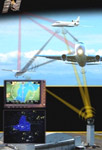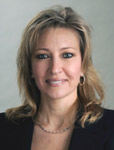
NEPA Process Slowing NextGen Progress, Says GE Aviation CEO

Lorraine Bolsinger, president and CEO of GE Aviation Systems
Lorraine Bolsinger, president and chief executive officer of GE Aviation Systems, told members of the U.S. House Aviation Subcommittee on April 21 that the environmental process is getting in the way of environmental progress in the NextGen program.
"NextGen" is the ongoing, wide-ranging transformation of the U.S. national airspace system from ground-based to satellite-based air traffic management, according to the Federal Aviation Administration (FAA).
Bolsinger and a panel of other witnesses gave testimony at the "NextGen: Long-Term Planning and Interagency Cooperation" hearing.
She said that technologies are now available to reduce aviation carbon dioxide (CO2) and other emissions, fossil fuel consumption, and aircraft noise. Bolsinger introduced Required Navigation Performance (RNP), a technology that harnesses GPS and advanced flight management systems on aircraft to create precise, predictable aircraft paths, to the discussion. According to Bolsinger, these paths can:
- enable optimized descents that require minimum engine thrust and fuel burn;
- reduce track miles an aircraft has to fly between a specific city pair, which lowers fuel burn and emissions, and
- ease the impact of noise by providing the flexibility to tailor aircraft paths.
"According to the FAA, the full implementation of NextGen could reduce greenhouse gas emissions from aircraft by up to 12 percent by 2025. The International Civil Aviation Organization has predicted that efficiencies made possible by just RNP can cut global CO2 emission by 13 million metric tons per year," Bolsinger said, adding that implementation of RNP at the 10 busiest U.S. airports could cut aviation CO2 emissions by 2 million metric tons a year.
"These benefits are well understood, well documented, and, as I speak, are being acted upon by airlines and countries around the world.
"Today, in Australia, we are helping Airservices Australia develop and deploy a nationwide RNP network that will reduce CO2, improve airspace efficiency and help control community noise. And in Canada, we designed and currently maintain a network of RNP arrival procedures for WestJet that is saving fuel, cutting emissions, reducing track miles and time enroute. Here in the United States, we are helping Southwest Airlines equip its fleet, train its pilots and make operational changes that will enable them to fly RNP paths," Bolsinger explained.
The problem, Bolsinger said, is "the bureaucracy and red tape surrounding the administration of NEPA. Current application of the environmental review process at FAA makes it practically impossible to implement meaningful change ─ even if that change improves the quality of the environment."
FAA subjects navigational procedure changes to some level of NEPA review. Bolsinger said that the review can last many years and costs hundreds of thousands of dollars. She noted, too, that the review process doesn't begin until the new navigation path is already designed and in some cases, approved.
"It's absolutely imperative that we find a way to help FAA streamline its environmental review process. We must find a way to expedite environmental approval for navigation procedures that provide clearly defined environmental benefits based on clearly defined metrics," Bolsinger said.
She offered a simple three-part test to "unlock the regulatory shackles that are binding NextGen." A new, expedited approval process should apply to any navigation procedures that:
- reduces an aircraft’s CO2 emissions,
- reduces fuel burn and,
- results in a reduction or no net increase in the noise-affected area on the ground.
Lorraine A. Bolsinger is president and chief executive officer for GE Aviation Systems LLC. A 28-year veteran of GE, Bolsinger was appointed to lead the systems business in October 2008 and most recently served as vice president of ecomagination. She earned a bachelor's degree in biomechanical engineering from the University of Pennsylvania.